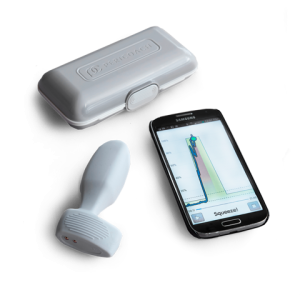How to Properly Exercise Your Pelvic Floor Muscles
You’re at a restaurant with the girls celebrating a friend’s birthday. Your always-hilarious friend recites an anecdote that has you roaring with laughter, and suddenly it happens—a few drops slip out. You panic, wondering if anyone will notice, and quickly excuse yourself to the restroom.
Sound familiar? If you’re like millions of women around the globe, you’ve experienced some form of urinary incontinence. Those few drops (or more) that slip out when you laugh, cough, or sneeze are not only uncomfortable, but embarrassing.

Missy Lavender, Founder and CEO of Women’s Health Foundation, believes one in three women across the globe suffer from urinary incontinence, with many more cases going unreported.
Reducing or eliminating urinary incontinence is just one of the many benefits of strengthening the pelvic floor (Kegel) muscles.
Below we’ll take a closer look at some of those benefits, define what the pelvic floor is, examine the problem of urinary incontinence in more detail, and move through a step-by-step Kegel exercise guide. We’ll also look at how assistive devices like the PeriCoach System can help you achieve your pelvic floor exercise goals.
What Is the Pelvic Floor?
The pelvic floor is a group muscles, ligaments, and connective tissues in the pelvis that support the bladder, bowel, and uterus. Life events, such as pregnancy, childbirth, and menopause, can all weaken or damage the muscles and other tissues of the pelvic floor. This can lead to a host of problems, including urinary incontinence, pelvic organ prolapse, and sexual dysfunction. This is why it’s so important for women to do Kegel exercises. Even women who haven’t been pregnant or who don’t plan on becoming pregnant can benefit from Kegel exercises.


Types of Urinary Incontinence
Urinary incontinence comes in many forms, including (but not limited to):
- Stress: Leaking a few drops of urine from physical exertion, such as coughing, sneezing, exercising, laughing, or exercising.
- Urge: Unexpectedly leaking a large amount of urine, during sleep, for example.
- Overactive bladder: Frequently and urgently needing “to go,” which may be accompanied by urgency.
- Overflow: Unexpectedly leaking urine because of a full bladder.
Some women may suffer from more than one type of incontinence at the same time. This is known as mixed incontinence.
Your First Line of Defense against UI
Despite pelvic floor muscle training being recommended as first line treatment for incontinence, at least 50% of women do not correctly contract their pelvic floor muscles with verbal or written instructions alone. An assistive Kegel exercise device can be an invaluable tool that provides something for women to squeeze against while doing pelvic floor exercises.
The PeriCoach pelvic floor exerciser provides even more—the innovative insertable device features three biofeedback sensors that detect the contractions of your pelvic floor muscles and send progress reports to your smartphone via Bluetooth. This constant flow of information helps provide visual guidance and feedback, track your progress and can be shared with your healthcare provider at your discretion.

The PeriCoach System
A Word about Fecal Incontinence
Ladies, it’s an unpleasant subject, but one that warrants discussion. There are many things that can lead to fecal incontinence (a loss of bowel control that causes you to pass stool unexpectedly), including long-term laxative use, rectal prolapse, and emotional problems. Injury to the anal muscles during childbirth and past gynecological or rectal surgeries are some of the more common causes of fecal incontinence in women.
If you’ve experienced a troubling loss of bowel control—however minor—talk to your healthcare provider, and know that pelvic floor muscle training can strengthen the muscles under the bowel, which may reduce the likelihood and incidence of fecal incontinence.
Okay, let’s get started with Kegels!

How to Properly Do Kegel Exercises
- First, you’ll need to identify the right muscles—the simplest way to do this is to stop urination midstream. If you succeed, you’ve identified your pelvic floor muscles. (It is not recommended to do this regularly, just to test you can find the right muscles)
- You can do Kegel exercises in any position—sitting down, standing, or lying down. We recommend lying down if you’re able, both because it puts less pressure on your pelvic floor, and because it enables you to use an assistive device. If you choose to lie down, get into a position as if you’re about to do crunches, with knees bent.
- Before you get into your most comfortable position, be sure to place your Kegel exerciser and a lubricant within reach (note: make sure the Bluetooth on your phone is enabled and that your smartphone and assistive device are synced).
- Now that you’re in position, lubricate and insert the PeriCoach device (if using), or, alternatively, use one or two fingers to help you feel your muscles contract. If you prefer to use nothing, that’s fine, too. If you are using the PeriCoach, select ‘Free Exercise’ in the programs to do the following steps.
- Tighten your pelvic floor muscles, holding the contraction for five seconds.
- Release, then relax for five seconds. Taking a deep breath, inhaling deeply, and exhaling slowly will help you relax involuntary muscles that are not under your conscious control.
- Repeat five to 10 times.
- Aim for at least three sets of 10 repetitions per day. Day-by-day, work your way up to keeping the muscles contracted for 10 seconds and relaxing for 10 seconds. You may also work your way through the pre-programmed exercise regimes within the PeriCoach app.
The relaxation phase of Kegel exercises is just as important as the contraction phase, especially for women who have experienced a tightening or shrinking of the vaginal muscles due to a prolonged period of celibacy or due to menopausal changes, which can interfere with enjoyment of penetrative sex.
It’s very important to keep the muscles of the abdomen, buttocks, and thighs relaxed during pelvic floor muscle training. However, your anal sphincter muscle should contract during Kegels. To distinguish between the muscles of the anus and those of the buttocks, squeeze your bum as if you’re doing backward leg lifts. Then squeeze your muscles as if you’re trying to stop yourself from having a bowel movement—you should feel the difference between the two contractions.
Also, avoid using Kegel exercises to start and stop your urine flow, which can lead to incomplete emptying of the bladder, and which can increase your risk for a urinary tract infection (UTI).
For those interested in pumped up “power” Kegels, here is the advanced version. Note: these exercises should be done without an assistive device.
- Endurance Training: Increase your hold time and decrease the rest period. Squeeze for 10 seconds and rest for three seconds. Repeat 10 times, once a day.
- Pulses: Contract and relax your muscles as fast as you can, then rest for 5 seconds. Do 30 per day, three times a week.
Focus on Menopausal Changes
Hormones are the main driver of the physiological changes women experience during menopause. The ovaries stop producing estrogen and progesterone, and the vaginal walls can become thinner, drier, and less elastic, which can lead to irritation and painful sex.
Menopausal changes can also result in loss of tone in the pubic muscles, which can result in pelvic organ prolapse. Exercising the pelvic floor is especially important for menopausal women, since stronger pelvic floor muscles may help prevent prolapse.
Benefits of Improved Pelvic Floor Strength
There are so many benefits to exercising your pelvic floor, including less reliance on costly, bulky pads, fewer worries about where the closest toilet is located, more pleasurable sexual experiences, and, most importantly, greater self-confidence and personal comfort. Women of all ages and stages of life strengthen their pelvic floor muscles, which in turn can:
- Reduce or eliminate embarrassing bladder leakage
- Improve pelvic floor strength after childbirth
- Reduce the likelihood of pelvic organ prolapse (POP)
- Reduce or eliminate urinary/bowel incontinence
- Improve confidence and reduce anxiety
- Improve intimacy, sexual satisfaction, and the ability to reach orgasm
Speaking of Improved Sexual Satisfaction …
Do we have your attention? Stronger pelvic floor muscles can lead to increased sensitivity during sex and stronger orgasms for women. The pelvic floor muscles surround the entire vagina and are the same muscles that contract during orgasm, so it stands to reason that stronger muscles could lead to stronger orgasms. Regular pelvic floor training can also lead to easier arousal and more enjoyable sex overall, in addition to the protection it provides against incontinence.

We hope this has been a fun learning experience about the importance of improving pelvic floor strength. Learn more about the PeriCoach System, recommended by experts. In the US, it is available by prescription from a pelvic health professional.


